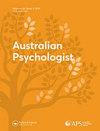Neuropsychological assessment of older Australian immigrant populations: considerations for clinical practice
IF 2
4区 心理学
Q2 PSYCHOLOGY, MULTIDISCIPLINARY
引用次数: 0
Abstract
ABSTRACTObjective By 2050, approximately one quarter of Australia’s ageing population will comprise culturally and linguistically diverse individuals. While a number of valid neuropsychological measures are available for use with English-speaking individuals, existing measures may not be appropriate for use with older immigrant populations. The purpose of this review is to highlight existing challenges facing the Australian neuropsychological community in the context of assessing older immigrant populations and offer suggestions to improve clinical practice.Method By conducting a review of existing research related to assessment of culturally and linguistically diverse populations, this paper provides a) a critical overview relating to factors known to impact on the validity of assessment outcomes, b) examines published Australian studies relating to neuropsychological test adaptation and the development of normative data for use with older immigrant populations, and c) offers recommendations to guide assessment and clinical practice.Results The use of existing English language test and norms has the potential to underestimate cognitive function in older immigrant populations, leading to erroneous diagnostic outcomes. These issues are related to a) level and quality of education, b) inappropriate test content, c) nonrepresentative normative data, and d) a lack of familiarity with test taking procedures.Conclusion Research addressing issues relating to cross-cultural assessment is gaining momentum within Australia, resulting in the development of demographically focused normative data and adapted tests to accommodate some cultural groups. Initial results have reported mixed success, indicating the need for further and carefully considered research.KEY POINTSWhat is already known about this topic: The prevalence of age-related cognitive disorders in Australia is predicted to rise over the next 30 years.A large number of elderly Australians represent culturally diverse older immigrant populations.Neuropsychological tests and norms are influenced by age, education, language and culture.What this topic adds: An overview of research identifying limitations of neuropsychological assessment within culturally diverse older immigrant populations.An overview of neuropsychological measures and norms that have been developed for use with culturally diverse older immigrant populations in Australia.Recommendations and strategies to improve assessment of culturally diverse populations in Australia.KEYWORDS: Older adultsethnic minoritycross-cultural neuropsychologynormative data AcknowledgementsThank you to Michal Boneh for assisting with critical feedback during the drafting process.Disclosure statementNo potential conflict of interest was reported by the author(s).老年澳大利亚移民人群的神经心理学评估:临床实践的考虑
【摘要】目的到2050年,澳大利亚大约四分之一的老龄人口将由文化和语言多样化的个体组成。虽然有许多有效的神经心理学测量方法可用于说英语的个体,但现有的测量方法可能不适合用于老年移民人群。本综述的目的是强调在评估老年移民人口的背景下,澳大利亚神经心理学社区面临的现有挑战,并提供改进临床实践的建议。方法通过对文化和语言多样性人群评估相关的现有研究进行回顾,本文提供了a)与已知影响评估结果有效性的因素相关的关键概述,b)检查澳大利亚发表的与神经心理测试适应和用于老年移民人群的规范性数据开发相关的研究,以及c)提供指导评估和临床实践的建议。结果使用现有的英语语言测试和规范有可能低估老年移民人群的认知功能,导致错误的诊断结果。这些问题与a)教育水平和质量有关,b)不适当的考试内容,c)不具代表性的规范性数据,d)对考试程序缺乏熟悉。结论:在澳大利亚,针对跨文化评估问题的研究正在蓬勃发展,从而形成了以人口为重点的规范性数据和适应某些文化群体的测试。初步结果报告的结果好坏参半,表明需要进一步仔细考虑的研究。关于这个话题的已知信息:在澳大利亚,与年龄相关的认知障碍的患病率预计将在未来30年上升。大量的澳大利亚老年人代表了文化多样化的老年移民人口。神经心理学测试和规范受年龄、教育、语言和文化的影响。本主题补充的内容:在文化多样化的老年移民人群中识别神经心理学评估局限性的研究概述。概述神经心理学的措施和规范,已开发用于与文化多样化的老年移民人口在澳大利亚。改善对澳大利亚多元文化人口评估的建议和策略。关键词:老年人、少数民族、跨文化神经心理学、规范性数据感谢michael Boneh在起草过程中提供的重要反馈。披露声明作者未报告潜在的利益冲突。
本文章由计算机程序翻译,如有差异,请以英文原文为准。
求助全文
约1分钟内获得全文
求助全文
来源期刊

Australian Psychologist
PSYCHOLOGY, MULTIDISCIPLINARY-
CiteScore
3.70
自引率
5.30%
发文量
32
期刊介绍:
The Australian Psychologist is the official applied practice and public policy journal of the Australian Psychological Society. As such, the journal solicits articles covering current issues in psychology, the science and practice of psychology, and psychology"s contribution to public policy, with particular emphasis on the Australian context. Periodically, Australian Psychological Society documents, including but not limited to, position papers, reports of the Society, ethics information, surveys of the membership, announcements, and selected award addresses may appear in the journal.
 求助内容:
求助内容: 应助结果提醒方式:
应助结果提醒方式:


